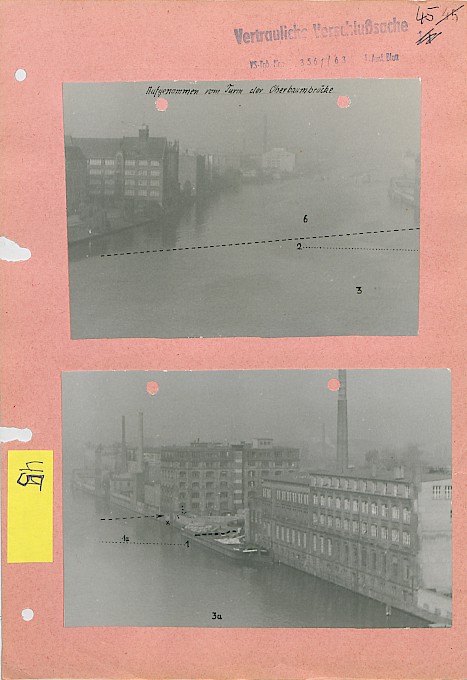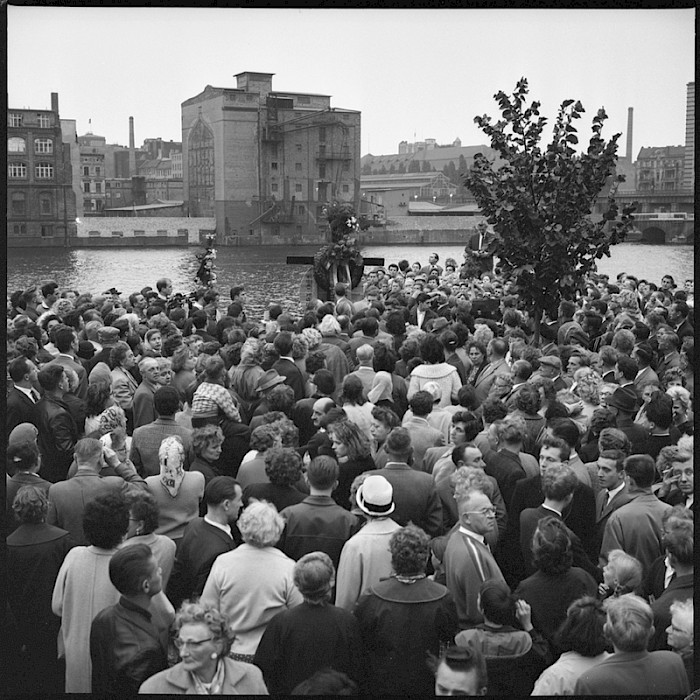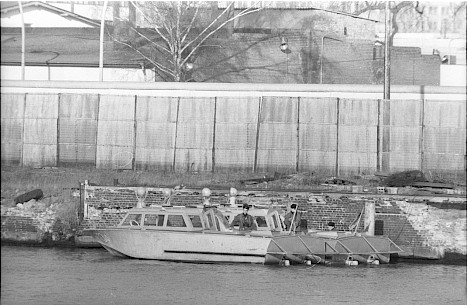Wall Victims who Died in the Border Area of Mühlenstraße
The Berlin Wall was meant to prevent people from leaving the GDR. In spite of the high risk, many people still tried to escape. More than 2.8 million GDR citizens were able to flee the SED dictatorship between 1961 and 1989. At least 101 people never made it to West Berlin; they died while trying to escape.

At least seven men died trying to escape on Mühlenstraße between 1961 and 1972. They were able to reach the border river because the buildings and courtyards in the area shielded them and visibility at night was poor. On several occasions, people managed to enter the water unnoticed and reach the West Berlin side. But Anton Walzer, Werner Probst and Manfred Weylandt were discovered by GDR border guards; the guards used search lights to illuminate the water at night and safeguarded the border river from their posts on bridges, land and boats. All three men had almost reached the safety of the quay wall on the Kreuzberg side of the Spree when they were fatally shot by border guards. Udo Düllick dodged the bullets but appears to have died of hypothermia and exhaustion. Philipp Held and Hans-Joachim Zock also drowned in the river, but their escape attempts were not discovered until later, when their bodies were retrieved from the water. An unidentified person drowned before the eyes of West Berlin residents. GDR border guards had also noticed him, but his body was never found.

Almost no escape attempts and deaths are known to have occurred along Mühlenstraße after 1972. By 1977, all the apartment houses, warehouses and factory buildings along the street had been demolished. The 3.6-meter-high "Border Wall 75" made it impossible to enter the border area and gain access to the Spree. The cleared area was now easily visible to the GDR border troops. They illuminated the grounds and could quickly detect any movement against the backdrop of the white wall. Only one young man succeeded in escaping in 1978: he jumped from a boat into the water and swam to the West Berlin shore.

People who were not attempting to flee to West Berlin also died in the border area of Mühlenstraße. The death of Ulrich Krzemien is curious. He swam through the Teltow Canal and reached West Berlin in 1962. Three years later, he swam through the Spree back to East Berlin, but drowned shortly before reaching the quay wall. A GDR border guard reacted too late, and the body was not retrieved for many days. Heinz Müller from West Berlin was drunk when he stood on a viewing platform at the Schilling Bridge and fell into the border fortifications. A border guard shot him and he died from his injuries.
West Berlin Children who Became Victims of the GDR
Four children drowned on the West Berlin bank of the Spree River between 1972 and 1974. Cengaver Katrancı (age 8), Siegfried Kroboth (age 5), Giuseppe Savoca (age 6) and Çetin Mert (age 5) were playing near the water when they fell into the river and could not get out by themselves. Although relatives and West Berlin rescue workers arrived at the scene, they were not allowed to enter the river because it belonged to the GDR. Members of the GDR border troops who were on boats, the riverbank and the Oberbaum Bridge did not react at all or too late.
Andreas Senk (age 6) also drowned in the border waters. GDR border guards evidently did not see him fall into the Spree on the morning of 13 September 1966.
Eventually, in October 1975, the West Berlin Senate and the GDR government made changes that allowed for the rescue of West Berliners in border waters. Fences were erected in the embankment area and warning signs were put up in both German and Turkish. Rescue posts were also installed at the border waters between East and West Berlin so that GDR border guards could be informed of an accident and help could arrive faster.
"And then this conflict takes place. You have everything, you could help, but you are not allowed to help because it is not politically desired."
Additional information:
Die Podcast-Reihe „Grenzerfahrung“ von der Stiftung Berliner Mauer entstand 2021 anlässlich des 60. Jahrestags des Mauerbaus und wurde gefördert von der Bundesbeauftragten für Kultur und Medien. In der Folge „Alltag in Teilung“ wird darüber gesprochen, wie sich das Leben im geteilten Berlin entwickelt hat. Die hohe Betonmauer gehörte zum Alltag der Bewohnerinnen und Bewohner Berlins. Aber nicht alle Menschen wollten die Grenzabriegelung hinnehmen, sie versuchten, aus der DDR zu fliehen. Expertinnen und Experten geben Auskunft über das Grenzregime der DDR und berichten von den mindestens 101 Menschen, die bei einem Fluchtversuch ums Leben kamen oder inhaftiert wurden. https://www.stiftung-berliner-mauer.de/de/stiftung/podcast-grenzerfahrung